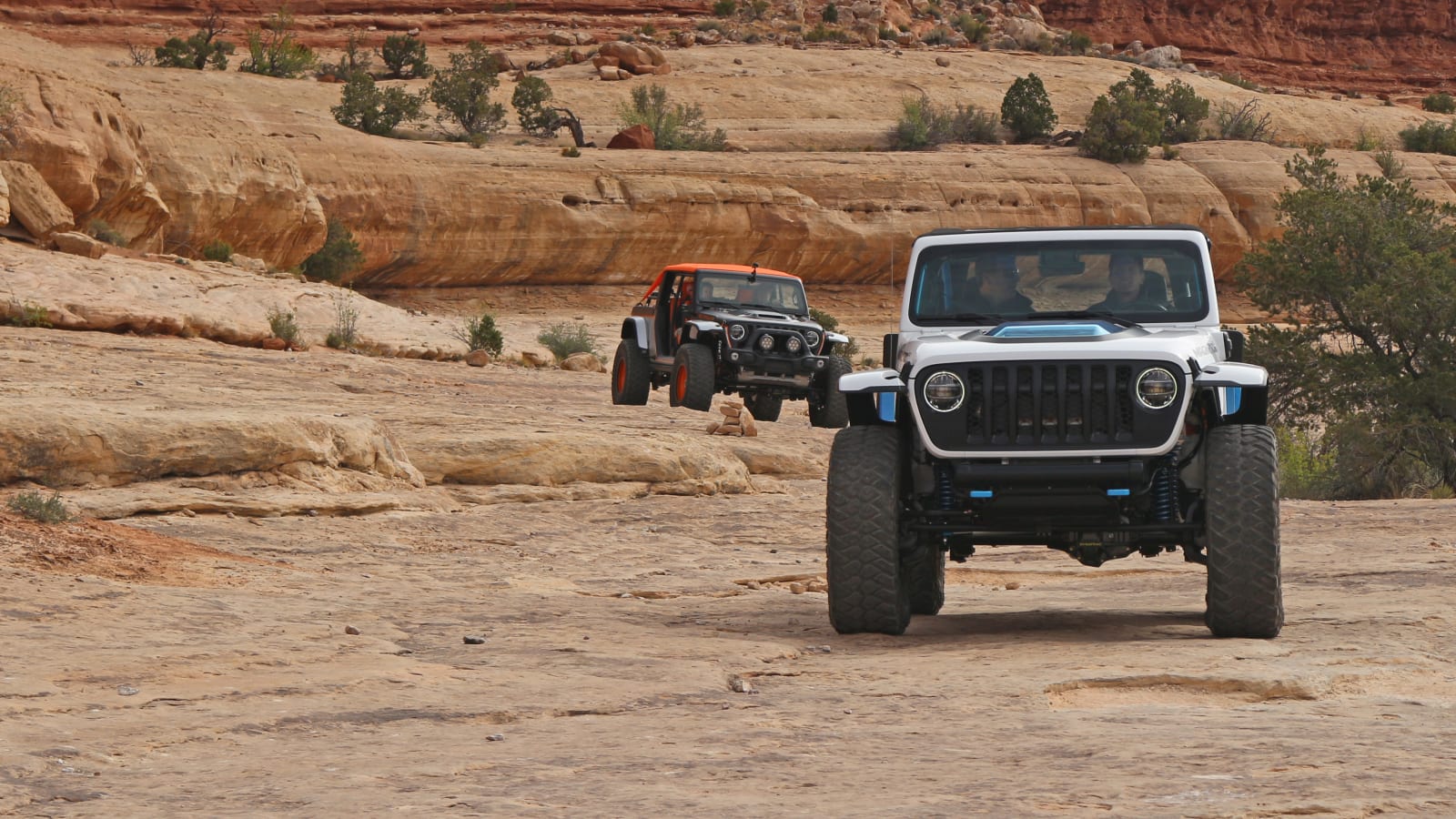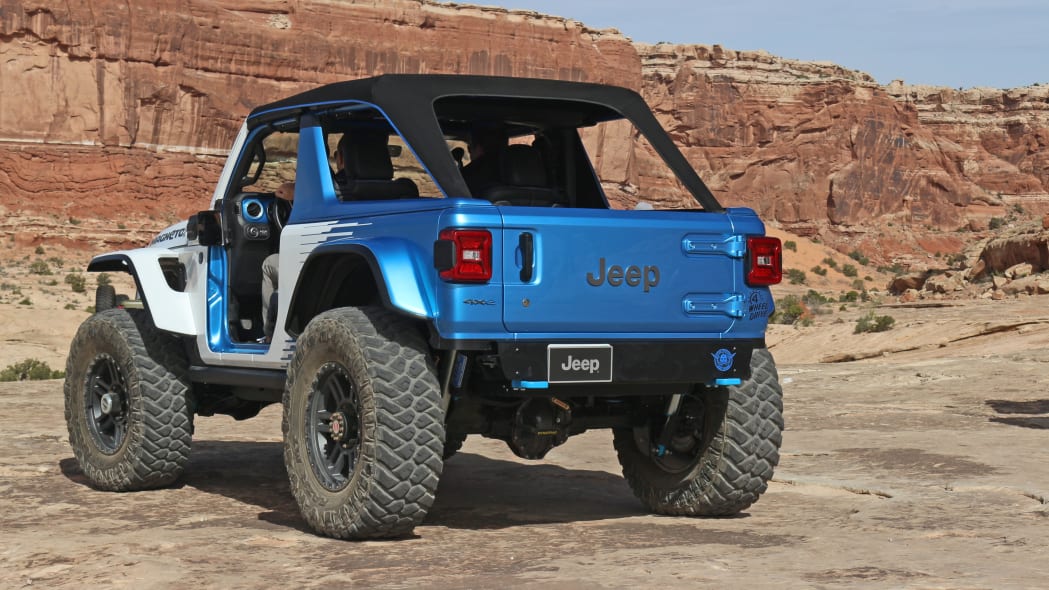MOAB, Utah — “Which way should I go?” I ask Jim Morrison, head of the Jeep brand for North America, as we depart our Easter Jeep Safari base camp outside Moab, Utah, for a little jaunt up and down some gnarly looking rock faces.
He glances at me for a moment, then looks toward the windshield and gestures broadly at the landscape. “It doesn’t matter. A Wrangler on 40s can go anywhere.”
True though that may be, this is no generic Wrangler I’m piloting. It’s the Magneto 2.0, which is Jeep’s second crack at an all-electric 4×4 concept. Magneto itself isn’t new, strictly speaking, but it has come a long way in a year. Version 1.0 boasted 285 horsepower and 273 pound-feet of torque; for 2.0, that’s now 625 horses and 850 lb-ft. A Wrangler on 40s may be able to go anywhere, but we don’t have room to see how fast.
You may be surprised to learn that Jeep didn’t actually upgrade the Magneto’s motors to achieve that output; they were capable of delivering that all along. The new ratings are a combination of new software parameters for the powertrain and an upgraded transmission that could handle the power. A manual transmission, at that — sourced from a Hellcat and dubbed “Tranzilla,” it’s further reinforced above and beyond Hellcat duty in order to handle the Magneto’s monster torque.
An electric car with a manual gearbox is a novel concept for a reason. Strictly speaking, it’s unnecessary. Transmissions exist to help cars take advantage of the relatively narrow band in which internal combustion engines produce usable power and torque. That concept is alien to EV design, at least for most scenarios, since electric motors generate torque from zero up to many, many thousands of RPM before their efficiency drops off. If combustion engines have a power band, electric motors have a power wedge, and it’s a mighty big one.
The cool part is, this makes the Magneto’s manual the easiest one on the planet to use. Since there’s no engine idle to maintain, it can’t be stalled. The clutch exists only to decouple the transmission from the driveline in order to shift gears, which you never really need to do (again, virtually infinite powerband). On paper, this should be the most engaging EV on Earth. In practice, the gearbox is a red herring; you simply pick the gear you want and press the throttle.
So, why bother even putting a transmission in this prototype? Well, mostly because it’s not really a prototype at all, but rather an exercise for Jeep’s engineers as they plot out the future of electrified off-roading. Simply plopping electric motors and batteries in place of the Wrangler’s existing Pentastar V6 and fuel tank was cheap, easy and quick (relatively speaking, of course) and provides Jeep with a testbed for more-focused development. In other words, it was already there and it did the job.
Knowing that doesn’t make it any less weird. Muscle memory kicks in every time the Magneto feels like it might bog down going uphill or when creeping over an obstacle. Neurons in some dark corner of my brain have fibers in my left leg on high alert, anticipating the lugging and eventual stall that never comes.
This is the long way around to telling you that Jeep has no intention of building an electric Wrangler with a six-speed gearbox, even if I think it would be pretty fun to play around with. But in a Jeep, there’s more to gearing than just getting the proper road speed for a given engine RPM. Technical off-roading (rock crawling, etc.) demands high torque at low speeds, which is why anybody who plans to do any serious wheeling will turn their nose up at a vehicle without a low-range gearbox.
This, Morrison says, is indeed where manual gear ratio control would prove useful. In fact, there are EVs out there with two-speed transmissions. Specifically, the Porsche Taycan and its Audi E-Tron GT cousin. They have two gear ratios, with the “high” gear being the default for most driving and a lower (numerically larger) ratio engaging in sportier drive modes to allow for quicker acceleration before transitioning to high gear somewhere above 50 mph.
While the mechanical layout is different, Porsche’s implementation works almost identically to a Jeep’s two-speed transfer case. By narrowing the operating speed range even further and utilizing an even shorter “low” gear, a hypothetical production Magneto could put 840 pound-feet to the ground from zero RPM with a “redline” that still limits it to single- or low-double-digit speeds. If you’ve never off-roaded, this notion may sound preposterous to you, but it’s the kind of fine control rock crawlers dream of.
So, Magneto is a showcase — a fascinating and freaky showcase, but a showcase nonetheless. Neither this nor anything with this powertrain setup will come anywhere close to production. But it’s an important sign that Jeep’s engineers are taking electrification seriously and (fingers crossed) indicative of what Jeep can accomplish in the electrification space.
Next time, maybe they’ll let us see just how ridiculous if feels to do 0-60 in a Wrangler in under 3.0 seconds. Whaddaya say, Jim? I’ll have my lawyers call your lawyers?
Related video:
Source: www.autoblog.com



